

| Trade log-in: | HERE | |
| Get password | Forgot password | ||

2015.3 | 2015.2 | 2015.1
2014.3 | 2014.2 | 2014.1 | 2013.3 | 2013.2 | 2013.1 | 2012.3 | 2012.2 | 2012.1
2011.3 | 2011.2 | 2011.1 | 2010.3 | 2010.2 | 2010.1 | 2009.3 | 2009.2 | 2009.1
2008.3 | 2008.2 | 2008.1 | 2007.3 | 2007.2 | 2007.1 | 2006.3 | 2006.2 | 2006.1
2005 | 2004 | 2003 | 2002 | 2001 | 2000
This edition of our newsletter is a little Burma-centric. Secretary of State Hillary Clinton’s visit to Burma two weeks ago is the first by such a cabinet member since John Foster Dulles went in 1955. To mark the occasion we offer a special star moonstone from Burma that is certain to enchant. Then we move back in time with more writing from Martin Ehrmann, accompanied by full-color slides from his collection. We then look to the future of a Burma on the move—with speed bumps ahead. There’s much more, too, as you can see. And, finally, let’s take this opportunity to say “Thank you” to all our clients, colleagues, contributors and collaborators. Happy Holidays and an Auspicious New Year!
After the holidays, we’re looking forward to the world’s greatest gem and mineral show in February. One-stop general information about individual shows can be obtained from the Tucson EZ-Guide.
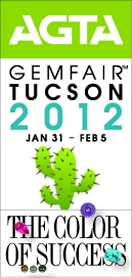 |
Pala International will be represented in Tucson as follows. We look forward to seeing our many friends there. Visit the Pala International Show Schedule for future events.
Pala joins nearly 100 exhibitors for this annual extravaganza.
Event: AGTA GemFair
When: January 31 – February 5, 2012
Where: Tucson Convention Center
Booth: 1016
The event website now features an interactive floorplan allowing you to see who is exhibiting by area of the convention center.
More than forty free seminars are offered by notables in the world of gemstones and pearls.
 |
Pala International and two dozen other world-class mineral dealers shack up at a Sonoran Desert resort.
Event: 11th Annual Westward Look Mineral Show
When: February 3–6, 2012
Where: Westward Look Resort
Suite: 224
See Pala International’s page on the Westward Look Show site.
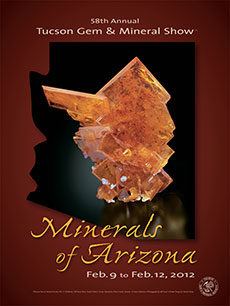 |
TGMS is the largest gem and mineral show in the country. This year’s theme is “Minerals of Arizona.”
Event: 58th Annual Tucson Gem and Mineral Show
When: February 9–12, 2012
Where: Tucson Convention Center
Booth: Aisle 5 East
A list of speakers was not available at e-press time. [back to top]
Many shows will offer their own shuttles. View your transit and parking options here. [back to top]
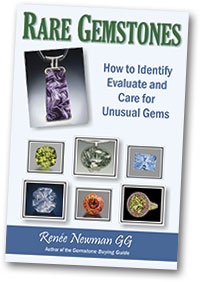 |
Renée Newman has just completed a new book, which will be released at the Tucson Gem show—Rare Gemstones: How to Evaluate, Identify and Care for Unusual Gemstones. Good information on non-traditional gems has been limited, so Newman decided to create a guide that gives concise, up-to-date details on their identification properties, geographic sources, treatments, imitations, durability, uses, value factors and pricing. In addition, Newman will be discussing non-traditional gems used in jewelry at a free AGTA seminar entitled “Increasing Sales with Exotic Gems” (Saturday Feb. 4, 9:00 a.m., Tucson Convention Center Greenlee Room). After the presentation, she will be signing books at the National Association of Jewelry Appraiser’s (NAJA) booth (AGTA G-11) in the Tucson Convention Center. Visit Newman’s website for more information. [back to top]
A phenomenal phenomenon. To understand what properties are at work here, we must start with feldspar, the most common mineral group found in the earth’s crust. Then we bounce light off the prism-like features that make up the crystalline structure within this gem and we illuminate the adularescent effect: a glowing, billowing light that seems to dance across the moonstone. As these internal structures start to line up in a repetitive pattern the light begins to concentrate and is refracted back out upon the surface of the stone as lines that form rays of the star. This is a common mineral with uncommon symmetry, filtering and focusing the light in a brilliant interface. The bottom half of the moonstone shows three rays of the star and a golden adularescence, while the upper half exhibits some of the blue sheen and traces of the star formation. The pattern morphs continuously as you move the light source above. The adularescence and star seems to float above the surface of the moonstone like the glow of a candle.
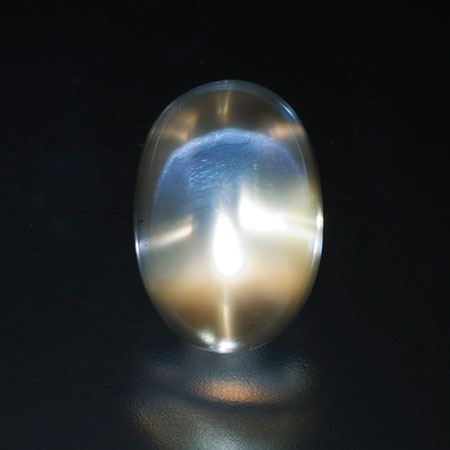 |
| Star from the East. Star moonstone from Burma, 4.57 carats, 13.24 x 9.15 x 5.87 mm. Inventory #18905. (Photo: Mia Dixon) |
Interested? Select the inventory number above, call or email us to inquire. [back to top]
Earlier this month, on our mining blog, Will Larson posted plats for the Esmeralda Mine and for Pala’s newest mining venture, the Mountain Lily Mine. The Mountain Lily also has been known as the Ware as well as the Emeralite No. 2. That reminds us: there’s a huge photo enlargement of jeweler-turned-miner John W. Ware at All That Glitters, the ongoing exhibition at the San Diego Natural History Museum. As a New Yorker, Ware saw the opportunity in San Diego County and relocated there in 1910, opening the store pictured below. In “California Gem Mining: Chronicle of a Comeback,” David Federman wrote that Ware was a role model for Pala International’s Bill Larson.
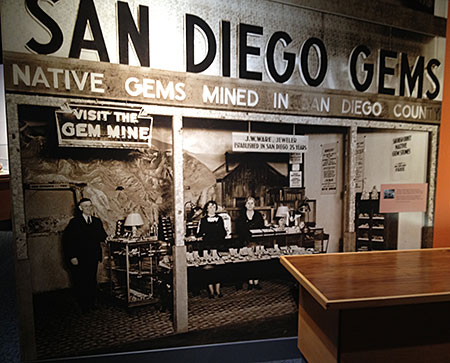 |
| Mine to market. The store pictured above was established 25 years before this photo was taken. Ware died in 1944, but after becoming one of the American Gem Society’s first certified gemologists. Below, from the All That Glitters display, two blue topaz crystals amid tourmaline—historical specimens from the Mountain Lily Mine. (Photos: Bill Larson) |
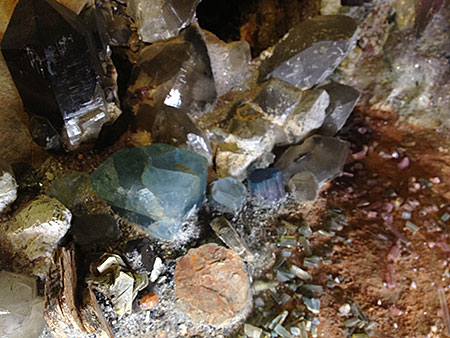 |
[back to top]
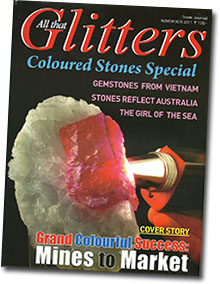 |
No, we’re not repeating ourselves. All That Glitters is a trade journal that last month featured guest editor Dr. Jayshree Panjikar, proprietor of Pangemtech, a gem lab and tech institute in Pune, Maharashtra, India. Dr. Panjikar, who was involved in last month’s Mines to Market conference in Jaipur, asked several attendees from around the world to discuss colored gemstones. Pala’s Bill Larson’s busy schedule prevented him from attending, but he nonetheless is included, with a look at San Diego County’s gemstone mining and more.
Read “The Rise, Fall and Rise of San Diego Mines of Bill Larson.” You’ll want to see the photo of Bill with a huge Burmese gem topaz crystal. [back to top]
Currently online for subscribers of The Journal of Gemmology (Vol. 32), is “Chemical and growth zoning in trapiche tourmaline from Zambia – a re-evaluation” by Dr. Karl Schmetzer, Dr. Heinz-Jürgen Bernhardt and Thomas Hainschwang.
This paper is the most recent and certainly one of the finest to come out regarding the rare trapiche growth phenomenon, i.e., a pattern displaying clear, separate and distinct growth sectors, this time in tourmaline. Most significantly, it follows up on one of its co-authors’ earlier papers published in the Spring 2007 Gems & Gemology (Vol. 43, No. 1, pp. 36–46), entitled “Trapiche Tourmaline from Zambia” by Thomas Hainschwang, Franck Notari and Björn Anckar—the two certainly should be kept together in the gemologist’s reference library (mine are filed under weirdites).
Trapiche growth is seen so far in just a very limited number of minerals including Mong Hsu rubies, andalusite and beryl—most notably emerald, but also aquamarine such as the extraordinary Namibian crystal cluster that John Koivula showed me in 2009 (this specimen was reported earlier in “Inclusions in Gems: Two unusual aquamarines,” G&G, Fall 2008, Vol. 44, No. 3, pp. 275–276); the latter’s type of growth presentation and ones like it are discussed in the present paper.* As anyone familiar with Dr. Schmetzer’s wonderful crystal drawings (found in his Alexandrite book and in his recent publications) will certainly agree, this paper’s numerous illustrations will appeal to all interest levels and will help illuminate this complicated natural wonder.
The paper begins with an introduction followed by a section on external morphology, which divides perpendicular-to-c-axis slices into three types (one of which is shown below). A geometrical description of the trapiche pattern is then discussed, also using slices of the three types cut perpendicular to the c-axis. Inclusions—key to the trapiche pattern—are examined next. Chemical composition is then evaluated; nearly 3000 point analyses were obtained using an electron microprobe. (This section comprises about seven of the study’s 23 pages.) The paper concludes with a discussion that ties the various aspects of the study together. It compares the present material with other trapiche types, and compares previous suggestions for the pattern’s formation. Their analyses show two intergrown tourmalines with different chemistry and it is concluded that this represents two growth stages or growth generations of the tourmaline. This section also includes a thoughtful look at nomenclature, distinguishing between two different mechanisms of formation in various materials that all have been named trapiche—with a suggestion regarding how to refine the term.
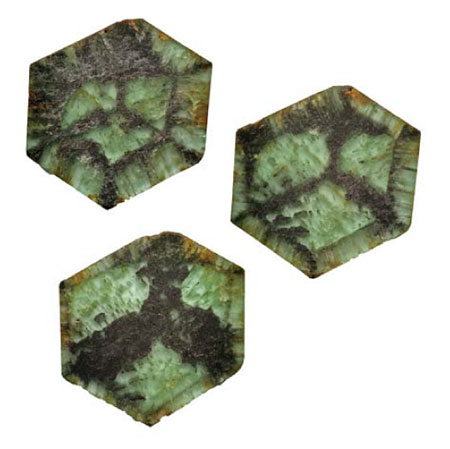 |
| Depending on your point of view, these tourmaline crystal slices can take on a cube-like three-dimensionality or could bring to mind the symbol for a luxury sedan. Shown are three slices (approx. 32 mm in diameter) from the same hexagonal trapiche tourmaline from Zambia cut perpendicular to the c-axis; in the center, a stationary three-rayed star separates three pyramidal growth sectors of the crystal; the rim consists of six prismatic growth sectors clearly delineated from each other and from the pyramidal growth sectors. The variations in cores and rims depend on the slices’ positions along the crystal’s c-axis. (Photos by T. Hainschwang in reflected light.) |
For a look at an even more complicated trapiche growth, which the present paper’s authors admittedly refrain from discussing due to its complexities beyond the scope of their discussion, see “Sakura Ishi (Cherry Blossom Stones): Mica Pseudomorphs of Complex Cordierite-Indialite Intergrowths from Kameoka, Kyoto Prefecture, Japan,” Rocks & Minerals, July/August 2006 (Vol. 81, No. 4, pp. 284– 292), by John Rakovan, Masao Kitamura and Osamu Tamada.
* For emerald see Kurt Nassau’s 1970 in-depth look at trapiche emeralds from Columbia, “Trapiche Emeralds from Chivor and Muzo, Colombia,” The American Mineralogist, March–April 1970 (Vol. 55, No.3–4, pp. 416–427). See also this erratum in the September/October (Vol. 55, Nos. 9–10, pp. 1808-1809). [back to text]
Note: Elise Skalwold is the recently appointed Editor of The Journal of Gemmology.
[back to top]
Our friends at the Opal Network Facebook page sent us an interesting item regarding an application of amorphous silica—yes, opal—in the sequestration of mobile uranium such as that which contaminates mine dumps and other sites. A research team at Stanford led by geochemist Kate Maher suggests imitating nature by using amorphous silica to do what it does so well on its own. Opaline silica deposits already have high uranium concentrations, but the deposits are sequestered within an “opaline embrace.” Read about the proposed application in “Besides Being Gemstones, Opals May Decontaminate Nuclear Sites.”
 |
| Anti-nuclear? Opaline silica, like the material that makes up this lovely white opal from Ethiopia, appears to have industrial applications. Inventory #19405. (Photo: Mia Dixon) |
[back to top]
Years ago, your editor knew a guy in Hollywood, a poet and actor, who had a vintage image of Elizabeth Taylor on his wall. Below it, a one-word caption: God. Indeed, when Liz was at her best, who could top her? Even in her absence, Elizabeth Taylor makes headlines—this week, by setting seven world auction records at Christie’s in a sale of Taylor’s collection, billed “The Crown Jewels of Hollywood.” Among the seven: a world record for the most valuable private collection of jewels sold at auction. A stellar performance.
When we last looked at the collection, we focused on Taylor’s love of emeralds. It’s fitting, then, that a single 23.46-carat emerald from Bulgari (Lot 29) set two world auction records—for an emerald, and for an emerald per carat. It went for nearly $6.6 million, or $280,000 per carat. The emerald and diamond necklace from Bulgari that Richard Burton bought Taylor while shooting Cleopatra in 1962 (Lot 28) fetched $6.1 million.
The New York Post quoted unnamed sources as saying that Bulgari had a private box at the New York sale from which it anonymously bought back about $20 million of its own creations, including the latter necklace. Per the Post, Bulgari also retrieved its sapphire and diamond sautoir (Lot 72) featuring a 52.72-carat sugarloaf cabochon sapphire from Burma. A gift from Burton to Taylor on her 40th birthday in 1972, the pendant brought in $5.9 million—nearly ten times the low end of its estimate.
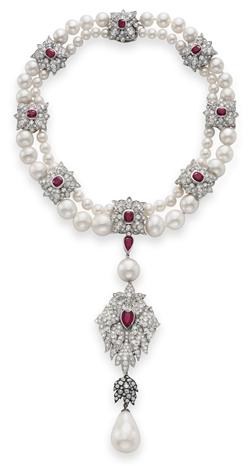 |
| La Peregrina’s wanderlust has taken her from the muzzle of Taylor’s Lhasa apso to the hands of a lucky buyer. (Photo: Christie’s press release) |
The Elizabeth Taylor AIDS Foundation will be the recipient of some profits generated by admissions, events and select publications related to the sales. [back to top]
…with apologies to Joan Baez.
 |
| Passed-over pink. This diamond had a pre-sale estimate of about $13 million. The December 7 sale’s items traveled to Geneva, Los Angeles and Hong Kong, but still no buyer for this one. (Photo: Sotheby’s Press Release) |
[back to top]
 |
| Red and green. Two natural Burma spinels from our Old Stock… New Pix. Above, a 1.77-carat classic red oval, Inv. #19339. Below, something a little more offbeat (and nicely reflected in the price): a darker green-blue 2.72-carat oval, Inv. #18965. (Photos: Mia Dixon) |
 |
Pop Quiz: Name the country with the most investment in Burma for the 2011–12 fiscal year. China? Thailand? Singapore? Wrong.
Answer: Korea. (South, that is.)
Now name Number Two. China? Thailand? Singapore? United Arab Emirates? Wrong.
Answer: Zip. No country other than South Korea has invested this year. That may change now that Burma was visited two weeks ago by the likes of Secretary of State Hillary Clinton. In a report on Clinton’s visit, Newsweek’s Ron Gluckman gushed that “with the government showing signs of a liberalizing shift, Burma is giddy with change.” A Reuters story on December 7 claimed that property prices in Yangon soared just hours after Clinton left the country. Several pundits have remarked on President Thein Sein’s reforms, including the halt (at least for now) of a power generation project benefiting China, in the face of local opposition. Prior to Clinton’s trip, Associated Press called Burma the “first rogue state to accept Obama’s offer to cooperate,” an offer he’d made when he took office three years ago.
Yet gemstone sanctions are still in place. On October 27, the Bangkok Post published a lengthy editorial by Renaud Egreteau, “Jade or Jaded? The sanctions on Burmese gems,” in which he once again deconstructed the logic behind the bans, yet still grasping for new methods of regulation. He opined that a Kimberley Process for the Burma gem trade is “difficult, if not downright unrealistic,” listing five barriers to such a project. He then gives lukewarm support for “the creation of an independent transnational regulation body to trace Burmese gemstones”—just the sort process that the U.S. Burmese JADE Act was to have set up but didn’t. Oh, we get weary...
[back to top]
With Pala Presents, we offer selections from the library of Pala International’s Bill Larson, who will share with us some of the wealth of information in the realm of gems and gemology. While much of the writing will be of a certain vintage, such as our 1957 reprint referenced here, more recent material also will be presented from Pala’s colleagues around the world.
Earlier this year we treated readers to Martin Ehrmann’s unpublished (and unfinished) manuscript, Ruby Mines of Mogok. We followed up with his 1957 Gems & Gemology article, Gem Mining in Burma, which contains substantial overlap. This month we offer Part One of another 1957 three-part article with material that will be somewhat familiar to readers of the other pieces. We offer it, however, so that people interested in the subject will have multiple resources as well as mid-century images of the mines, methods, miners and dealers of Mogok and elsewhere.
Burma, The Mineral Utopia, was published in the second half of 1957 by The Lapidary Journal. Ehrmann recalls his frustration with relatively paltry mineral and gem field work, and the subsequent delight at discovering the Elysian Fields of Burma. Two months in Burma, Ehrmann wrote in his preface, could yield more than 250 mineral specimens and some rare gems. In Part One of this three-part series, Ehrmann focuses on Mogok, discussing the geography, people and mining methods.
Ehrmann also gives his take on the geology of Mogok after stating, “The origin of the Mogok gem area has not been described anywhere, as there has been no scientific investigation made to date.” Readers of our sister e-publication, Pala Mineralis, will have seen another of this month’s Pala Presents offerings: a PhD dissertation by Kyaw Thu, “The Igneous Rocks of the Mogok Stone Tract: Their Distributions, Petrography, Petrochemistry, Sequence, Geochronology and Economic Geology,” completed in 2007.
 |
Also this month we present full-color images from Ehrmann’s slide collection, such as the above, a monochrome of which appeared in Part Two of “Utopia.” See Ruby Mines of Mogok – Slide Show. [back to top]
— End December Newsletter • Published 12/16/11 —
In this edition of our newsletter we look at gems, gems, gems. Smoky opal, phenomenal peridot, cleaving calcite, canny corundum, pearl’s papa-mama, and rajas’ riches.
Flooding in Thailand continues to devastate. This month we suggest you support The Ganoksin Project, which has been a forum and resource for jewelry makers since 1996. Ganoksin’s Hanuman Aspler is shown above, paddling through his offices! Visit Ganoksin’s "flood journal” and then for every $35 you donate, you are entered in a drawing for $10,000 worth of gift certificates from jewelry supply firm Rio Grande. Donate today and the following could be yours.
• First prize: $5,000 Rio Grande gift certificate
• Second prize: $3,000 Rio Grande gift certificate
• Third prize: $1,500 Rio Grande gift certificate
• Fourth prize: $500 Rio Grande gift certificate
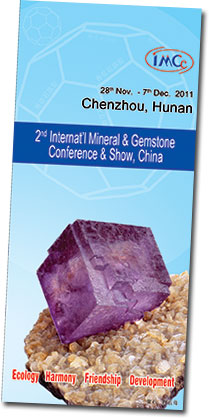 |
| Download the brochure. |
Chenzhou, Hunan, China will host the 2nd International Mineral & Gemstone Conference & Show beginning with a pre-conference auction on November 27. A one-day conference will be held November 28.
A mineral and stone fair, November 28 through December 7, will feature 30,000 square meters of dealer displays and 5,000 square meters of special exhibitions. The event wraps up with a visit to either the Shizhuyuan Mine or Baoshan Mine.
According to show publicity,
Chenzhou is a world-known mining center and has been producing a large amount of world-class minerals, including beautiful fluorite and calcite, valuable bournonite and stannite, and rare hsihuanite etc.
More information is available from the sponsor, AAA Minerals. [back to top]
The International Colored Gemstone Mines to Market conference was held earlier this month in northwestern India’s Jaipur—the Pink City (a reference to the city having taken on a rosy hue for a visit by the future Edward VII). A précis of the proceedings is available on the conference’s website.
In a follow-up email regarding the conference, presenter Richard W. Hughes stated that the event was perhaps the best he had ever attended.
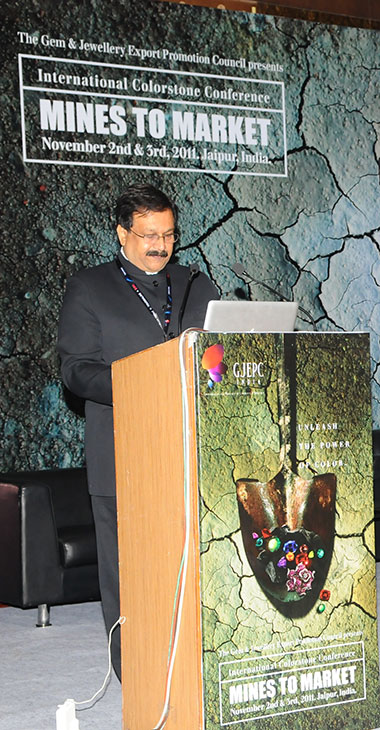 |
| Rajiv Jain. chair of Gem and Jewellery Export Promotion Council of India, which organized the conference, inaugurates the proceedings. (Photo: Gagan Choudhary) |
 |
| Speakers and organizers. See how many luminaries you can name by sight. Click to enlarge. (Photo: Gagan Choudhary) |
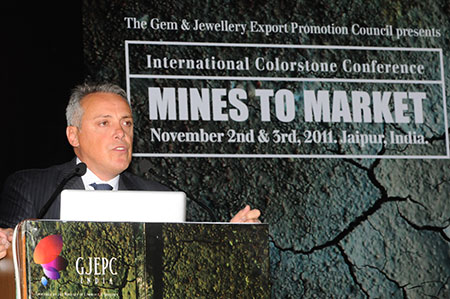 |
| Alberto Milani, CEO of Buccellati Americas, was the keynote speaker. (Photo: Gagan Choudhary) |
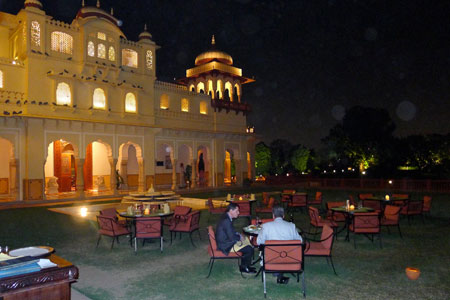 |
| R&R. In addition to the 5-star accommodations of the conference venue, the modern Jaipur Marriott, there was time for attendees to enjoy the Rajasthan’s many historic hotels. (Photo: Federico Bärlocher) |
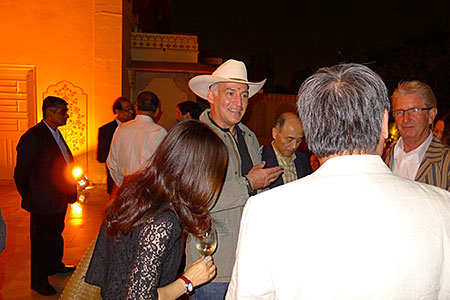 |
| Sacred cowboy. Master of ceremonies Yianni Melas (sporting hat and bindu) talks with attendees, who heaped praise upon him and other conference organizers. (Photo: Federico Bärlocher) |
 |
| Observant. Gemologist Drom E. Dary sports a Remembrance Day poppy at an outing in Pushkar. More photos featured here. (Photo: Yiannis Papayiannis) |
MC and conference organizer Yianni Melas told us that it was his idea to hold the event at the same time as the Pushkar Camel Fair, which mixes commerce, religious pujas, the arts, and sports into a memorable mélange. Not only did attendees have to rub elbows with camels, Melas was determined that everyone should be accommodated in tents in order to make the experience even more memorable. “Many years ago,” he told us, “when I first came to this amazing gathering of nomads I was fascinated by the feeling of massive culture infusion this event left me with.” This was an India apart from the bustling streets of Mumbai. “I promised myself that I would bring my friends to this place and celebrate this amazing culture with them.”
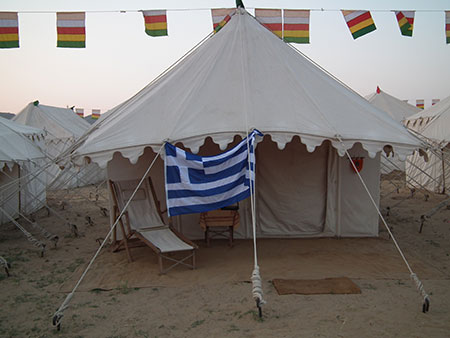 |
| Roughing it? Sleeping tent above with Greek flag (a sign of Yianni Melas’s heritage); dining tent below. (Photos: Federico Bärlocher) |
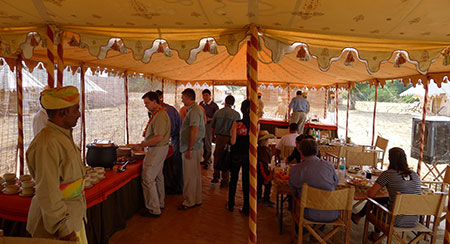 |
 |
| Eye for color. This participant in the camel fair has a harlequin turban and sand-reddened eyes. (Photo: Yiannis Papayiannis) |
 |
| Did we mention sand? Eddie Bell, who presented at the conference, travels in style at the festival in Pushkar. (Photo: Manuj Goyal) |
[back to top]
 |
| Bhupinder Singh, who for the first four decades of last century was Maharaja of Patiala, performs his princely duty. |
If you missed it at the Victoria & Albert two years ago, you have a second chance to see “Maharaja: The Splendor of India’s Royal Courts,” which just opened at San Francisco’s Asian Art Museum. Actually, the two shows are not identical, since the Asian Art Museum has different donors and the museum is using some objects from its own collection.
In this day of Occupy Oakland just across the bay, we might be given pause regarding the prospect of ogling opulence, as was Qamar Adamjee, the museum's assistant curator of South Asian Art.
The word maharaja evokes for many an image of a bejeweled and turbaned ruler, whose authority is absolute, whose wealth is immense, who indulges in a lavish lifestyle. …
An exhibition on the splendors of India’s royal courts initially aroused my skepticism. There should be more compelling reasons for an exhibition than merely to admire two hundred beautiful objects.
A quote from the V&A website bears repeating, however, because it is an indication of the thoughtfulness with which the exhibition has been crafted.
The vision of a king in all his splendour was believed to be auspicious. It was central to the concept of darshan, the propitious act of seeing and being seen by a superior being, whether a god or a king. Although originally a Hindu notion, the idea of darshan became an integral aspect of kingship throughout the subcontinent.
The website link above contains several images of examples from the exhibition. Following is a tempting sample.
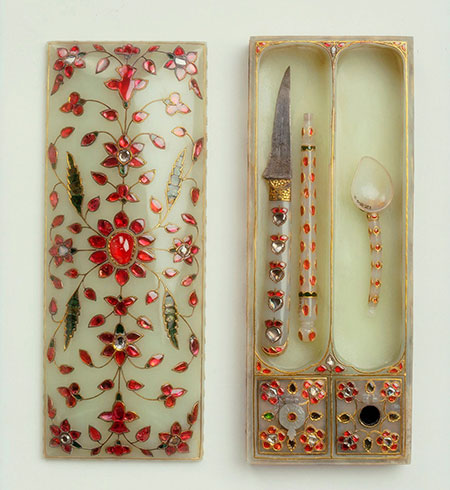 |
| Jade pen case, 1700-1800. White jade, rubies, emeralds, diamonds, steel. Click to enlarge. (Photo © V&A Images/Victoria and Albert Museum, London) |
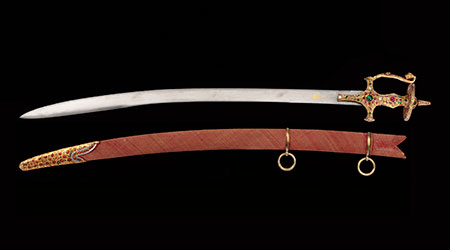 |
| Sword, Indore, about 1800. Steel, gold, diamonds, emeralds, rubies. Indore was one of the most important Maratha states. It held out against the British until December 1817, when Company forces defeated the young Maharaja Malharrao Holkar and captured the state treasury. This sword probably belonged to the Maharaja himself as it is richly encrusted with gemstones and engraved with the chhatra, or royal parasol. Click to enlarge. (Photo © V&A Images/Victoria and Albert Museum, London) |
Valuation of the treasure at Sree Padmanabhaswamy Temple, amassed for a couple of centuries by the maharajas of Travancore, was to begin as early as November 9, according to an October 16 story in The Hindu. The valuation process would require moving the metal objects into special wooden boxes, with equipment to be used to judge the artifacts’ purity. Each object will be entered into a database and be photographed three-dimensionally. Even X-ray fluorescence will be used in cases of unknown metals.
A committee appointed by the Supreme Court expressed worries that jewels and gold items were languishing in iron trunks in humid vaults. Eventually the contents of all six vaults will be consolidated in a secure storage facility to be built near the existing vaults. The new facility will feature “micro-climate zones” in several chambers.
For background, see our coverage from September.
See some superb gem treasures from Portugal, and lengthy descriptions, courtesy Rui Galopim de Carvalho, on Facebook. The yellow chrysoberyl pendant will floor you. From the third quarter of the 18th century, it is a monochromatic masterpiece housed at the Museu Nacional de Arte Antiga (do a search on “gemas” at that website and see some ecclesiastical objects).
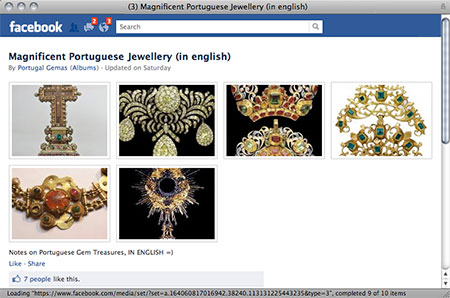 |
[back to top]
This month we feature the bounty of the corundum family: all-natural Mozambique ruby, Madagascar blue sapphire, and a Madagascar purple sapphire. This is a beautifully vivid trio exhibiting the best in each class. Just some of the freshly picked gems from Bill and Will’s recent trip to the Far East.
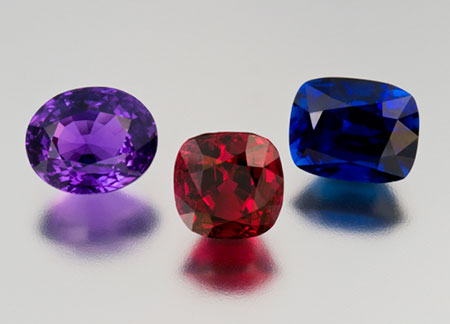 |
| Tempting trio. Purple sapphire (Inventory #19551), ruby (Inventory #19548), blue sapphire (Inventory #19550). (Photo: Mia Dixon) |
The 3.59-carat ruby comes to us from Mozambique, where some of the finest natural reds are being produced currently. Reminiscent of the Burma pigeon’s-blood red color, this dark and intense crimson stone illuminates in the daylight.
The 3.65-carat blue sapphire was mined in Ilakaka or perhaps in Andranondambo, Madagascar, once again where the finest of natural blues seem to bubbling up lately. It features rich, Kashmir-like blue with deep saturation and a classic cushion cut.
The 3.70-carat natural purple sapphire was most likely mined in Ilakaka, Madagascar, famous for fancy colors. This unique sapphire is quite amazing, shifting from purple to violet in different light sources. Vivid color raises the purity to levels rarely seen in sapphire.
For information on the gemstones of Madagascar, see “Sorcerers & Sapphires” by Richard W. Hughes, Vincent Pardieu and Dana Schorr.
Interested? Select the inventory numbers above, call, or email us to inquire.
Two new entries are available on blog.Palaminerals.com, our mining weblog. [back to top]
Be aware, an old treatment process has been put back in the pipe and is, well, smoking the Ethiopian opal out. This smoking process, dating back to the 1980s, has been reintroduced to some of the white “Wollo” opal from Ethiopia to create a dark body color. This hydrophane opal is an ideal candidate for smoking because of its porous nature, which allows the smoke to penetrate, leaving an even, dark body color behind.
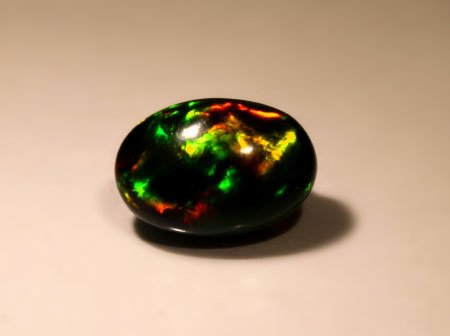 |
| Smoke and fire. Smoke-treated Wollo opal. (Photo: Bear Williams, © Stone Group Laboratories, LLC) |
Once you get familiar with the treatment, you could sight-ID these treated opals by seeing pockmarks and smoke concentrations. Laboratories simply look for carbon peaks at 1150 cm-1 (Raman) indicating burn residues. The treatment is stable and would even take some re-polishing since the smoke is deeply penetrating. The problem isn’t the treatment—it’s the unscrupulous characters trying to pass the opal through as natural black opal.
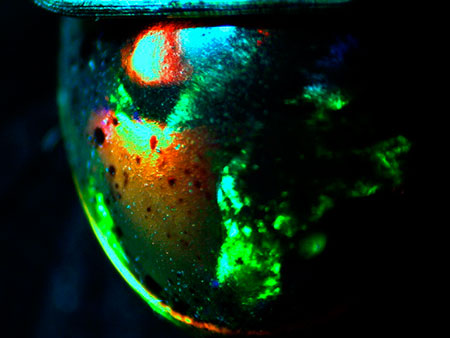 |
| Sooty. Carbon (smoke) spots inside smoke treated opal. (Photo: Bear Williams, © Stone Group Laboratories, LLC) |
For more information on this treatment see “Smoke Treatment in Wollo Opal” by Bear Williams and Cara Williams, of Stone Group Laboratories. [back to top]
We recently received a note from Norwegian mineralogist Reidar Åmli regarding “some old material in my collection, some small pieces of peridot containing cat’s eye effect.” Because cat’s-eye and star peridot is relatively rare, we received permission to publish photographs, and received images of two more specimens.
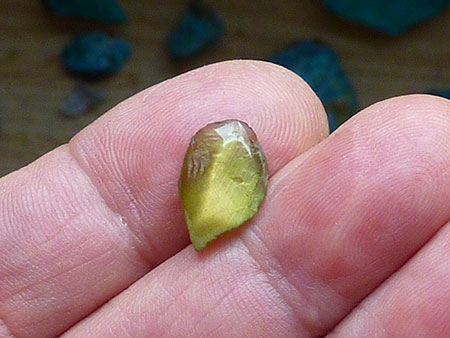 |
| Cat’s eye. Originally, Reidar Åmli described the phenomenon in this peridot specimen, illuminated by daylight above and halogen light below, as cat’s eye (chatoyancy). Pala’s Bill Larson opined that a cabochon of this material, if properly oriented, could display a four-rayed star, though so far, Åmli has not observed this in the stones in his collection. (Photos: Reidar Åmli) |
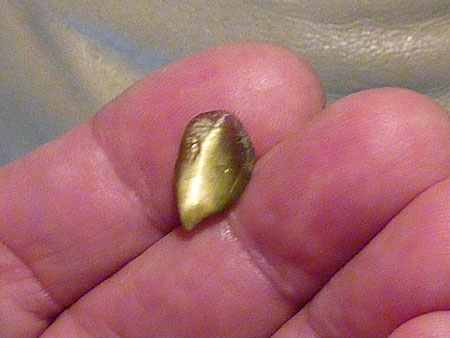 |
The above stone, 5.58 carats, was collected in the Åheim olivine mine, located south of Ålesund, Norway. The mine, described for a 2008 excursion as part of the International Geologic Congress, is at the largest commercial olivine deposit in the world, with potential production of over 400 years. Peridot is the green gem variety of olivine.
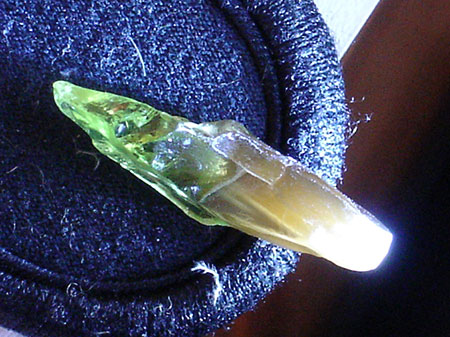 |
| Scattering photons? Transmitted light shows, according to Åmli, “the transition from normal peridot to this variety. However, I believe it is more a question of schiller rather than true cat's eye.” (Photo: Reidar Åmli) |
The adjective chatoyant in English comes from the present participle in French, chatoyant. The Micro Robert French dictionary defines it as: Qui a des reflets vifs et changeants (“That which has sharp and changing reflections”). The French word derives from chat (“cat”) and oeil (“eye”), i.e., the reflective quality of a cat’s eye. In gemstones, the phenomenon is caused by the material’s fibrous structure or by linearly oriented inclusions. When it is displayed via a cabochon cut, the fibers/inclusions run parallel to the stone’s base, and the distinctive gleaming streak runs perpendicular to their direction, just as is seen when light strikes a spool of silk thread. In reports of rare chatoyant peridot, these inclusions have been observed to be dendritic while others are thin and rectangular (G&G, Summer 1987) and have even been observed in chatoyant pallasitic peridot as parallel tube-like inclusions (G&G, Summer 2008). Chatoyancy is exemplified by the gem known simply as cat’s eye, as seen in our October 2009 featured stone, a round 13.25-carat chrysoberyl cat’s eye, which showed how two light sources could cause the eye to “wink.” This razor-sharp eye is due to the sheer density and fineness of extremely tiny acicular growth tubes. (PhotoAtlas Vol. 1).
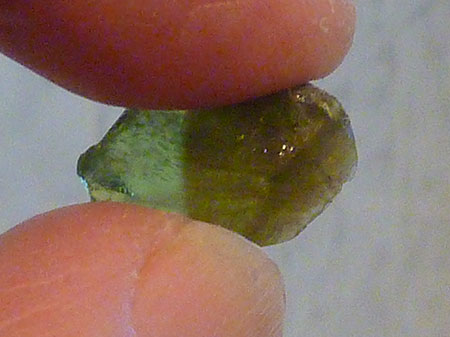 |
| Phenomenal mysteries? Åmli characterized the display in this 13.8-carat peridot as adularescence or scattering of light. When observing this specimen while changing orientation of the light (images above and below), Åmli questioned whether adularescence might also be applied to the first specimen above. (Photos: Reidar Åmli) |
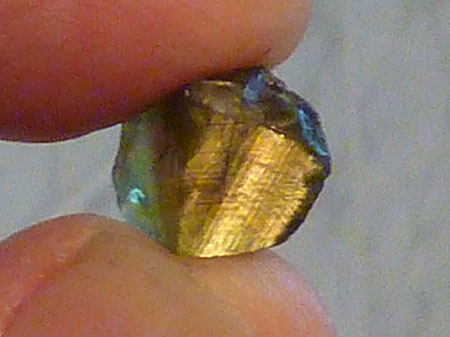 |
It’s possible for optical phenomena to co-exist, such as in feldspar sunstone like this cabochon that exhibits aventurescence, adularescence and asterism.
We’ve had nomenclature discussions before (“Feldspar, Fastidiously”), so if you have thoughts on what may be going on in this peridot, email us with feedback. [back to top]
You float on the sea/ Sleep on the surface/ Light through the fog
—Sigur Rós, “Ára bátur” (“Row boat”)
Editor’s Note: While the following might appeal more to readers of our sister publication, Pala Mineralis, the “phenomenal” nature of these materials may be of interest to colored gemstone enthusiasts as well.
On November 1, BBC pointed to a new new study of “Viking sunstone” and its application by navigators under conditions such as starless summer nights and foggy days. “Icelandic rocks could have steered Vikings,” the article’s headline declared, and it was accompanied by a photograph of seven orange-hued cabochons. We (and many others, as it turns out) knew of Elise Skalwold’s interest in this material, which we reported in June 2009, in Pala Mineralis.
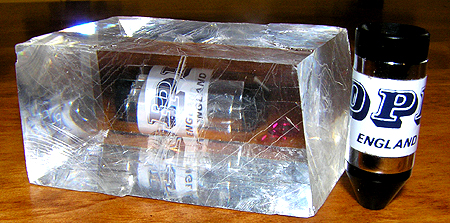 |
| Double duty. Objects viewed through the calcite appear double. Each image represents one of the rays of light which has been split off and polarized by passing through the doubly refractive calcite. (Photo: Elise Skalwold) |
We should remark that “Icelandic rocks” is not very descriptive of any of the possible minerals thought to be the Viking sunstone referred to in the ancient Sagas; the two most likely suspects are optical calcite and iolite (the gem variety of cordierite). The latter is a strongly pleochroic mineral, sometimes referred to as Viking Compass, while the former is well-known for its ability to show strong doubling. Sunstone (or Solstenen) refers to its navigational utility and should not be confused with varieties of feldspar, such as the orange-hued aventurescent stones pictured in the BBC article. The Telegraph, for its part, used the correct material in its photo.
The new study, “A depolarizer as a possible precise sunstone for Viking navigation by polarized skylight,” published in Proceedings of the Royal Society A, was conducted by an international team led by Guy Ropars of the Université de Rennes, in France. The study concluded that Viking navigators could have determined the direction of the Sun by using birefringent crystals as polarizers, under conditions such as cloud cover and even twilight. (A previous study, published in the same journal in 2007, also examined the method’s efficacy under foggy and cloudy skies.) See Discovery Channel’s Discovery News for the study’s highlights and an excellent description of how the crystals could have been used.
As Discovery News pointed out, no Iceland spar (calcite) has been found in excavations of Viking villages. But even centuries after the advent of the magnetic compass, it’s possible that such a crystal was used: an Iceland spar was found in the remains of the late 16th-century ship now referred to as the Alderney Elizabethan Wreck, as first reported in Leif Karlsen’s Secrets of the Viking Navigators (about which, more below).
 |
| Spot-on. This unpolished cleavage rhomb was obtained by Leif Karlsen in Iceland from an unknown locality. It is shown with a box he carved to protect this fragile specimen with its famous easy cleavage. The black spot is a bit of tape applied for navigation experiments. (Photo: Elise Skalwold) |
As a response to the many notices sent to Elise Skalwold regarding the new study, she posted her take on the subject in MailTalk, Gem-A’s email forum, which reads in part:
While some use the idea to romance the stone (such as iolite), I’ve always thought it was a great teaching model for polarization, pleochroism and birefringence—as well as reaching into other areas of study. A professor here at Cornell Univ. is teaching a class in archaeological navigation, including the Viking sunstone and I’ve hoped to use it in a gemmology/mineralogy related program here as well. There is a long list of interesting references at the bottom of [my “Fabled Viking Sunstone”] page, pro and con…
Elise then pointed to an article in the October 2011 edition of Elements, titled “Tourmaline the Indicator Mineral: From Atomic Arrangement to Viking Navigation,” by University of Manitoba’s Frank C. Hawthorne and GIA’s Dona M. Dirlam. This article (as Elise likewise noted on her own “Fabled Viking Sunstone” page) suggests three strong possibilities for crystal material whose navigational avail originally was mentioned in a medieval Icelandic saga legend. The candidates: tourmaline (probably elbaite), cordierite (aka iolite) and calcite. (Elise also mentions the highly pleochroic andalusite.) Cited by all three scholars is Leif Karlsen’s Secrets of the Viking Navigators, a book that Elise feels “makes a very strong case” for calcite due to the abundance of optical-quality material, “which can even be found in the surface scree.” For more on a famous mine in eastern Iceland, see Leo Kristjansson’s 2002 article from Journal of Geoscience Education, “Iceland spar: The Helgustadir Calcite Locality and its Influence on the Development of Science.” For photos of the locality, see The Giant Crystal Project and a companion locality page, both hosted by The Strahlen Foundation.
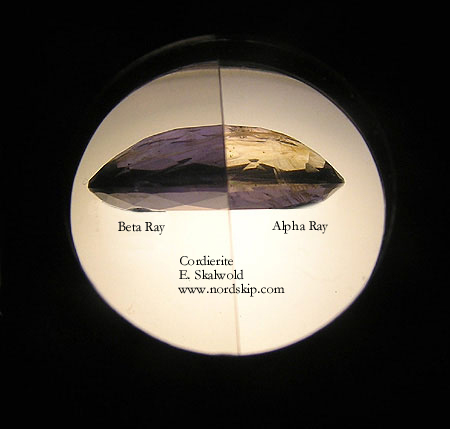 |
| Shifty. Pleochroism demonstrated in cordierite, variety iolite. An illustration of trichroism in this stone, via gamma ray, can be seen here. (Photo: Elise Skalwold) |
A stone with which one could see where the sun was in Heaven.
—From St. Olav’s Saga
The Elements article bases its discussion of optics on the above-mentioned 2007 study, which was led by Ramón Hegedüs of Budapest’s Eötvös University; the study is available now in its entirety. Of most interest to colored gemstone lovers would be pleochroism in iolite/cordierite, as illustrated above. As Elise mentions in her discussion of the subject, iolite-as-Viking Compass was the theory favored, as early as 1967, by Danish archeologist Thorkild Ramskou who in fact coined the term. But calibration in order to find the direction of the sun (in cloud cover) would have presented a challenge.
One region in Norway famous for cordierite, especially the classic (and now emptied) locality of Østerådalen, according to Mindat, also happens to be famous for aventurine feldspar—aka sunstone. [back to top]
Gemologists know that interpretation of crystal growth patterns can answer difficult questions regarding inorganic precious materials. Pearls and their hosts can be considered from a similar perspective—looking at the structure and process of assembly of the materials they are made of. This calls for a tour of biogenic mineralization, a widespread mechanism in nature where hard, inorganic material is created within organisms. BioMineralix, an interdisciplinary network hosted by the European Cooperation in Science and Technology (COST) framework, is one place to look for pearls in this field.
Nacre happens to be one of the most popular subjects of the field, with a century and a half’s worth of papers behind it. [1] Pearls were always part of the story. Natural pearls have been associated with the presence of shell growth anomalies in early field reports (T. H. Haynes, Proceedings of the Malacological Society, 1924, PDF here), a scenario of pearl growth that is still observed in mollusks, such as this one:
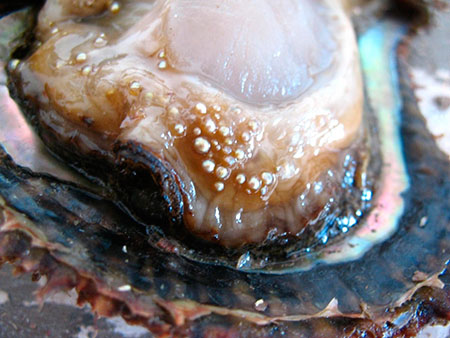 |
| Pearl-peppered Pteria (sterna). Dozens of golden seed pearls, above, produced by a heavily injured Pteria sterna, aptly also known as the “Rainbow Lipped Pearl Oyster.” The shell displays a large repair as evidence of its dramatic story of survival: in the image below, the patch of nacre featuring folds and small embedded pearls is a second layer of nacre lining—detached from the exterior of the shell. This shell and its dozens of pearls were donated by Douglas McLaurin (Perlas del Mar de Cortez) for study. Fresh shell photo: Douglas McLaurin. The second photo shows the current state of the specimen, presently at the University of Granada. |
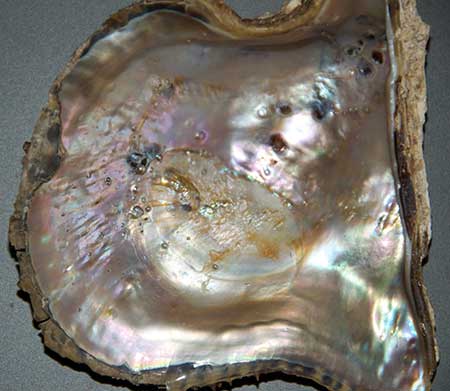 |
In addition to standard nacre growth corresponding to ideal models of self-assembly [2], exceptional circumstances yielding mineralization anomalies in shell repairs [3] and cultured pearls [4] are subjects of interest. As in nature, natural pearls are also rarer on paper. So are pearl gemology questions; an imaginary follow-up on Haynes would need to thread lightly through a collection of interconnected disciplines. The working groups of BioMineralix give a taste.
BioMineralix is an interdisciplinary network funded by COST, which aims to coordinate potentially fragmented research investments in Europe, and to facilitate worldwide collaboration, in nine key “domains,” including Biomedicine and Molecular Biosciences. This particular domain funds dozens of “actions,” including that of BioMineralix’s Action TD0903, described here.
Perhaps not unlike the way in which some inorganic gemology questions (think: origin determination) may relate to crystal growth and earth sciences, the questions that systematic surveys of current pearl culture conditions can’t answer off the bat tend to be difficult ones. The current discussions of pearl nomenclature and identification [5] fit the bill. Answers may not be readily on the shelf, but there isn’t much far beyond the shelf of biogenic mineralization that gemologists and the rest of the pearl trade do not have in their analytic toolbox already.
The common ground remains to be charted in a common language. Pearls—especially the morphologies sought to be significant for gemology—will have to be made accessible and significant to debates of biogenic mineralization. Of course, the recipe is not new, taking the ongoing exchange of notes between pearl farming and biogenic mineralization as a case in point. [6] Natural pearls have some catching up to do since the 1930s.
 |
| Pearl skin. Spirals like this one are often noticed when nacreous bivalve pearls get under reasonable magnification; a large example may reach approx. one millimeter in diameter. The intriguing interlace of nacre growth fronts on pearl’s skin and shell has been associated with liquid crystal patterns (Cartwright et al., PNAS, 2009, archived here). Interestingly, such arrangements are often draped symmetrically around pearls, not unlike the more visible growth marks and defects. Click to enlarge. (JEOL Neoscope, high vacuum setting, 10Kv, 400X magnification; close-up – 3400X; image taken at the Department of Stratigraphy and Paleontology at the University of Granada) |
Editor’s Note: Ana Vasiliu, of Bucharest, Romania, contributed to this article. [back to top]
Has it really been ten years since pale feldspar was transformed into the sunstone that would capture the imagination of television shoppers, eventually to become the subject of scandal? If you haven’t already seen it, Richard W. Hughes’s “Andesine: Timeline of a Controversy” will take you year by year, month by month through an account of veracity and verisimilitude.
As this gemological plot nears its dénouement, Hughes returns to Tibet with wife Wimon Manorotkul and daughter Billie Hughes—and Oregon sunstone industry insider Dana Schorr. It was Schorr who first suggested to Hughes that some red andesine might be too good to be true. They decided to go unannounced a few months ago. As Schorr says in his to-the-point postscript,
Neither our driver nor our guide knew our plans until the last minute; indeed, even I was unsure we would be able to visit the deposit.
On that note, you can begin by boarding the train for the roof of the world, in “Faith: In Search of the Lost Andesine Mines, Part Two.”
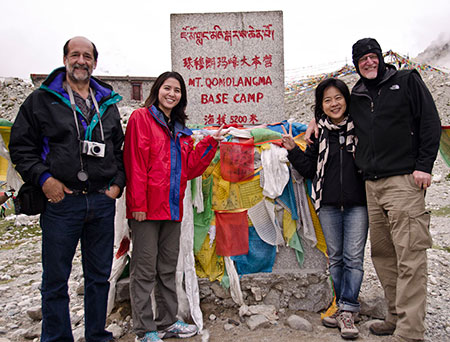 |
| Don’t forget your mittens. Dana Schorr, Billie Hughes, Wimon Manorotkul and Richard Hughes stand at the base camp of Mt. Everest (Mt. Qomolangma) in the sweltering chill of mid-summer at 17,000 feet. (Photo courtesy Richard W. Hughes) |
[back to top]
— End November Newsletter • Published 11/17/11 —
In this edition of our newsletter we offer a harvest cornucopia of news and information. See our cinnamon stone—perfect for mulling (over)—and our our new mining blog—ready for haunting.

Thailand, as you surely know, is experiencing the worst flooding in half a century. Please give back to a country that has given the colored gemstone industry so much. We can suggest The Thai Red Cross Society, but whatever your choice, please give. Thank you.
Pala International will be offering fine mineral specimens at this year’s Munich Show.
When: October 28–30, 2011
Where: Munich Trade Fair Centre
Hours:
Friday, October 28: 9:00 AM – 7:00 PM (Trade only)
Saturday, October 29: 9:00 AM – 7:00 PM
Sunday, October 30: 9:00 AM – 6:00 PM
Booth: Hall A6 Pavilion Booth 29
This year’s special exhibit is titled “European Classics 2011,” which brings to the show treasures from some of the most renowned museums and private collections, including the tourmalines from Elba, in the Tuscan Archipelago; hessite from the Museum of Natural History Vienna; fifty specimens leaving the British Museum of Natural History for the first time; Kongsberg silvers from Norway and gold specimens from Romania; and many more. See a streaming video overview here.
The centerpiece of these European Classics will be an exhibit of interest to colored gemstone lovers, on the history of the Wittelsbach-Graff Diamond, as the state of Bavaria celebrates The Blue Year 2011, to mark the death of King Ludwig II in 1886. Ludwig’s kindness was legend even if his attention to regnal duties lapsed in later years. He funded construction of the famous Bayreuth Festival Theatre that features the work of Richard Wagner each summer, and built a series of extravagant castles and palaces, a legacy that draws tourists to this day. (See this photo essay from The Atlantic for a taste.) Declared insane, having a sexual secret, and dying mysteriously, Ludwig’s story has been told by writers, filmmakers, playwrights, musicians—and at least one cartoonist.
While known for minerals, the Munich event includes a show-within-a-show: Gemworld Munich. As of May 30, 240 exhibitors were on board for the third year that this “world” is offered.
For more information visit the show website. See the Pala International Show Schedule for future events. [back to top]
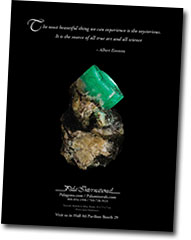 |
| See our ad in this year’s program. |
[back to top]
In a New York Times article published June 19, regarding jeweler Laurence Graff’s inroads to China, home to burgeoning billionaires, somehow we missed a line.
The Wittelsbach Graff sold recently for an undisclosed amount.
This famous blue diamond would have made quite an attraction were it to be displayed at the Munich Show, this being The Blue Year and all. We were told by Dan Ravasz, publicist for the show, that as late as September 23 there was a possibility, but the webpage for the special exhibit on the diamond’s history has dashed those hopes. Replicas, such as the one shown below, will be used to “present the three last known grindings of the stone” in the exhibit. This will include the most recent, executed by Graff, and reducing the 35.5 carat weight by 4.45, a move that left aestheticians apoplectic in early 2010.
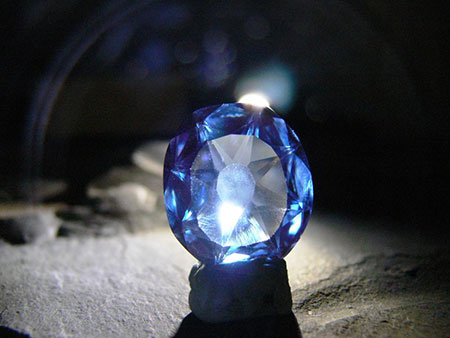 |
| Bavarian blue. Above, a spinel replica of the Wittelsbach (pre-Graff recutting) by Rudolf Dröschel (copyright by Dr. Bernhard Graf). |
Compared with some of the “stop-the-cuts” commotion at the time, the Munich Show website today puts it mildly: “Although the stone became more ‘fire’”—GIA upgraded it, in fact—“it lost its significance as a Bavarian leading stone.” Antwerp’s Gabriel Tolkowsky, whose great uncle Marcel originated the modern round brilliant cut, told Der Spiegel that recutting the Wittelsbach portends the approaching “Ende der Kultur.” Hans Otto Meyer, director of Berlin’s Deutschen Historischen Museums remarked that the new faceting (which, for the record, maintained the pattern of the original) was like painting over a Rembrandt. To which, Graff’s son François also made a fine-art comparison, telling BBC, “If you discovered a Leonardo da Vinci with a tear in it and covered in mud, you would want to repair it. We have similarly cleaned up the diamond and repaired damage caused over the years.” This is a repair that, according to Richard Wise, even if performed on a smaller blue diamond, would have added at least $500K—per carat.
For more on the Wittelsbach-Graff, see Gary Roskin’s “An Evening with the Blues: Part IV – Together again for the first time?” Roskin tells us that Part V will appear shortly in a revamped Roskin Gem News Report. [back to top]
Early next month the “first ever” International Colored Gemstone Mines to Market Conference will be held by the Gem and Jewellery Export Promotion Council of India (GJEPC), in Jaipur, Rajasthan. As its name implies, the conference assembles experts from around the globe to discuss the international colored gemstone market. It follows the GJEPC’s International Diamond Conference held last year.
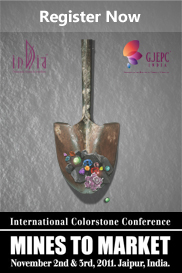 |
Pala International’s Bill Larson was slated as a speaker, but he is unable to attend, due to conflict with the Munich Show, above. The company he would have kept includes the following, taken from the show website.
GJEPC calls the gems and jewelry industry “undoubtedly the fastest growing industry in the world.” India is a key player in an industry that has shown relative resiliency in the face of marketplace challenges, thus providing the country with economic and employment benefits. In Jaipur alone, the Council claims that over 100,000 people are involved in the colored stone trade.
GJEPC chairman Rajiv Jain is quoted on the website: “We are the leaders in manufacturing emeralds and tanzanites and Jaipur is key when it comes to colour stones in India. Through such efforts, GJEPC hopes to establish India as a complete market from where all needs can be sourced—in short make it a One Stop Shop for the global consumers.” [back to top]
This month we feature a hessonite garnet from Sri Lanka.
Hessonite is a variety of the grossular species in the garnet group. Also referred to as “the cinnamon stone” due to its golden orange hue, hessonite takes on the color of fall and the upcoming Halloween spirit. Hessonite is known for its heat wave effect or roiled appearance internally which can be diagnostic for the variety.
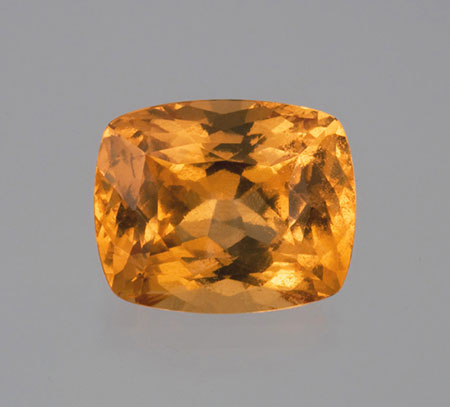 |
| Cinnamon stone, from Sri Lanka, 23.21 ct, 18.02 x 14.85 x 10.81 mm. Inventory #13351. (Photo Mia Dixon) |
This 23.21-carat hessonite is definitely large for its kind and comes to life with a beautifully faceted cushion cut. An unusual beauty, suited for the rare garnet collector or a specimen to work into a fall fashion piece of jewelry.
Check out all the wild varieties of garnet we have at Pala—from andradite, pyrope, spessartite and rhodolite—here and begin your search.
Interested? Select the inventory number above, call (phone numbers below), or email us to inquire. [back to top]
Visit Pala’s new blog devoted to the development of our mining ventures, blog.Palaminerals.com. The lineup so far includes:
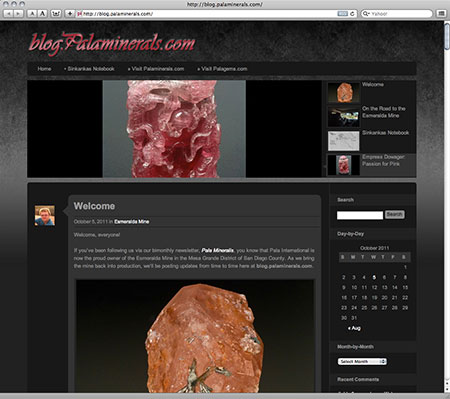 |
Feel free to use the blog’s comment feature to leave feedback or ask questions. We’ll be refining other features in the coming days. The blog is built in WordPress, so if there's a plug-in you’d care to suggest, or something’s not working, don’t hesitate to email the editor.
As Pala International moves into new mining ventures, we offer the following, from a lode of our own data mine. The following quote, from Corning’s A Student Reverie: An Album of Saxony Days (Frieberg near Dresden), appeared in our May 1997 edition of The Gem Spectrum, which was edited by Pala’s own Gabrièl Mattice. It followed some notes by Bill Larson on underground mining methods in Mogok, Burma.
Of all scientific subjects, geology, geologists, and gemologists, are probably the least narrow and prosily materialistic. In the pursuit of geological studies, gemology, par excellence, there comes into play a mysterious inspirational power derived from close association with Nature’s huge creations and forces. Set with sublimest scenery, in a supernatural atmosphere of beauty and with the marvelous unfolding of Nature’s ways, the awakening consciousness of the eternal powers, the majesty of conception, the everlastingness of time, material, force and movement, and of resulting life itself, create an intimate approach along the paths of science, to the vary gateway of the unfathomable secrets and mysteries of life. These awe-inspiring, magnetic influences and the dawning comprehension of universal greatness, transmitted through these poetic and scientifically romantic contacts, are those who cultivate the reverential expanding vision. You who strike through and bring to the surface in the fullest refinement of the finer traits and aspirations. Making he or she at his or her best... The Gemological scientist.”
—Sir Frederick Gleason Corning, 1920
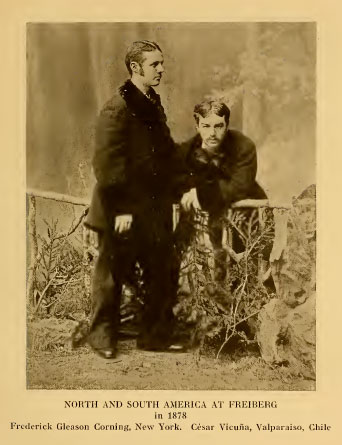 |
[back to top]
Some time back we heard through the grapevine that Elise Skalwold was being considered for editorship of The Gemmological Association of Great Britain’s (Gem-A) prestigious periodical, The Journal of Gemmology (JOG). This was confirmed last month in the pages of Gem-A’s bimonthly magazine, Gems & Jewellery, current edition. Elise, who has filled our own pages with items of interest, currently writes abstracts for JOG and Gems & Gemology, and has served as guest editor and author for ICA’s InColor magazine.
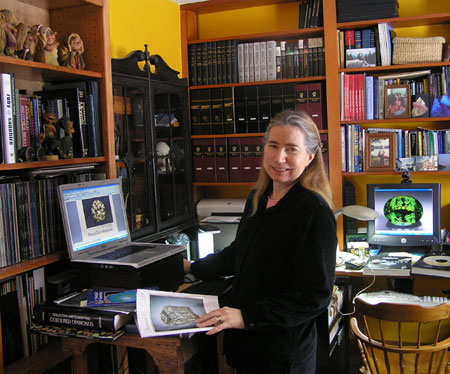 |
| Elise Skalwold, the new editor of The Journal of Gemmology. |
We can say from our own experience in working with Elise on several articles that she has a keen eye for detail, precision and principle. Our readers also know that she takes an interest in both mainstream and tributarial subjects in the gemological and mineralogical world. Elise succeeds Roger Harding as editor, which is an honorary position appointed by the board of directors of Gem-A. We congratulate both Elise and Gem-A for this selection. [back to top]
So, why not plug The Journal of Gemmology a little more? The current issue includes an article by Dr. Karl Schmetzer, whose work we’ve highlighted (alexandrites in Zimbabwe, his monograph Russian Alexandrites). “Measurement and interpretation of growth patterns in chrysoberyl, including alexandrite” is the current article. The study looks at growth zoning features in alexandrites from Russia, Sri Lanka and Brazil, and twinned chrysoberyls from Madagascar are examined in depth. Read the abstract here.
At Carat Gem Lab, interspersed between lovely representations of a wide range of colored gemstones, are now dozens of identified inclusions. The photomicrographs feature both natural and synthetic examples. See the gallery here.
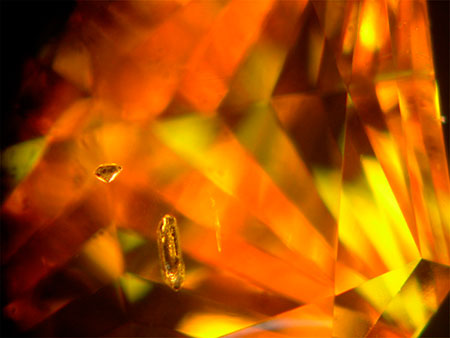 |
| Metal minis. Two metallic inclusions trapped in a yellow synthetic diamond. To the right of them is a small, white, slightly reflective fracture. From the gemstone and inclusions gallery at Carat Gem Lab. For a study of this material in China see the July–September 2011 edition of Australian Gemmologist. |
Days after American Gemological Laboratories (AGL) performed on-site testing at the Hong Kong show late last month, AGL and GemResearch Swisslab (GRS), in a Hong Kong/New York datelined press release, announced an agreement regarding lab reporting. Since late 2007, AGL had characterized lead-glass ruby/corundum as “composite ruby” and as of 2010 GRS had applied the term “hybrid ruby” to the same material. As of October 3, the labs’ reports will read thus:
GRS
Identification: Synthetic Glass/Treated Ruby (GRS-type “Hybrid Ruby”)* *Comments: Heat-treated and filled with a colored foreign solid substance (including lead). Special care required when handling. Also known as Composite Ruby.AGL
Identification: Composite Ruby
Comments: This stone is a composite of natural ruby and a high lead content glass. Also known as Hybrid Ruby.**See Enhancements section of the AGL report for additional comments related to the durability and special care of this product.
[back to top]
The same edition of Journal of Gemmology featuring the article on chrysoberyl growth patterns, which we referred to above, contains an article that reminded us of an industry concern that we covered a few years ago.
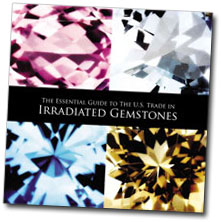 |
In “A Russian Maxixe beryl?” (abstract here) researcher Lars Olov Andersson states that colorless Russian beryl, when irradiated, could display the deep blue color of Maxixe beryl.
Immediately we were reminded of the issue of blue topaz irradiation, which we raised nearly five years ago, in a series of articles. The next-to-last in that series announced that former AGTA president Rick Krementz had been licensed by the Nuclear Regulatory Commission to test gemstone radiation. The lab, which goes by the name of GemClear, has suspended operations, according to a September 21 article in National Jeweler. The reason: Krementz said the NRC “unofficially” has ceased enforcement of its own regulations on irradiated colored stones. Shades of listeria-laden canta—er—loupe?
As the article notes, in July the Jewelers Vigilance Committee began giving the trade “a refresher course” on the regulations. Brush up on it here.
In our notice of the international “mines to market” show in Jaipur, above, we remarked on the resiliency of the colored stone industry. Diamonds, it seems, are another matter, if a move by Harry Winston is any indication. A week ago, the diamond firm, which produces rough in Canada’s Northwest Territories, announced it would “not make broader rough diamond sales into an unstable market that seeks bargains.” This means “significant rough sales revenues from this period will be deferred into the fourth quarter, and possibly subsequent periods.” The firm also noted that Jewish and Indian holidays at this time of year traditionally have lulled the rough diamond market, with “a return to normality” expected in November. See also this October 11 story from Financial Post.
 |
Online jeweler Blue Nile may have set a milestone, selling a diamond engagement ring costing more than $300,000. Previously, according to a story by Internet Retailer (IR) on September 15, “frequent” sales had been made at Blue Nile in the thousands to tens of thousands.
While skeptics claimed that certain classes of product were beyond the PC pale, smartphones have opened things up. IR gives the example of Dungarees.net, which saw smartphone sales jump from 1% in 2009 to 8% this year. Dungarees aren’t diamonds, of course, but the trend will be one to watch. [back to top]
Ronald Ringsrud, in a recent report, stated that fine emeralds “were moving” at last month’s Hong Kong show. Commercial stones didn’t fare so well, however. Ron quotes Pala International’s Bill Larson as saying that current economic concerns at the show caused Asian buyers to do little but just “kicking tires.” Also in Ron’s report is a photo of 20-, 40- and 60-carat emeralds from a 50,000-carat yield of rough from the Mina Real, a small mine near the Muzo mine. Photos from just after the June discovery, of the rough being pawed and polished, are eye-opening.
The glow of the light of daybreak is in your emerald vault, the goblet of the blood of twilight is your blood-measuring bowl.
—Rumi, b. 1207, birthplace often cited as Afghanistan
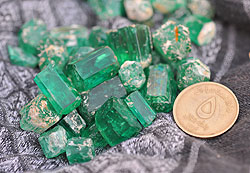 |
| Emeralicious. The Panjshir Valley continues to produce fine emeralds such as those shown here. The diameter of the coin is ~2 cm. (Photo: Vincent Pardieu; Copyright GIA) |
GIA’s G&G eBrief is posted publicly with a bit of a delay, so the July 6 edition is the current edition. It includes a brief (you expected otherwise?) update on emerald mining in Afghanistan by GIA Bangkok’s Vincent Pardieu and Guy Clutterbuck of CGM Ltd., Dublin. They spent three days in the Panjshir Valley, and while they’d hoped also to travel to two of the other major mining areas of Jegdalek and Badakhshan but, well, there’s a war on. And the embargoes of war affect the miners, as you will read.
That production was good at the time of the visit, last May, may be reflected in the several emails Pala receives from what are purported to be U.S. military personnel wanting to liquidate their stash. The report also discusses how Afghanistan’s export system might be improved to promote legal distribution.
Recently, we received two calendars from a series on North American jades from Roger Merk, who our readers may recognize as the force behind the annual Sinkankas Symposium. These are fifteen-month calendars starting with October 2011 and finishing with December 2012.
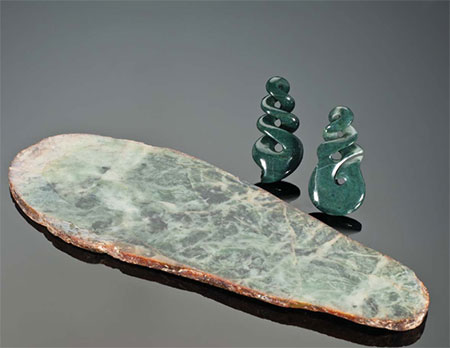 |
| Made in China? Clear Creek jadeite slab and two current Chinese-carved pieces from similar material. California’s Clear Creek area is apparently closed to collecting jadeite at this time, but much of the material is available for purchase in California. Click to enlarge. (Photo: Robert Weldon) |
There are 17 full-color pictures in each calendar, taken by Robert Weldon from GIA, that clearly show the many beautiful varieties displayed by jade. Roger tells us there will be several more jade calendars produced this year, including jades of British Columbia, jades of Washington State, jades of Guatemala, jades of Alaska, etc. One can purchase these calendars directly from Roger Merk for $10 each plus mailing. Or you can call 619.971.2018 for details.
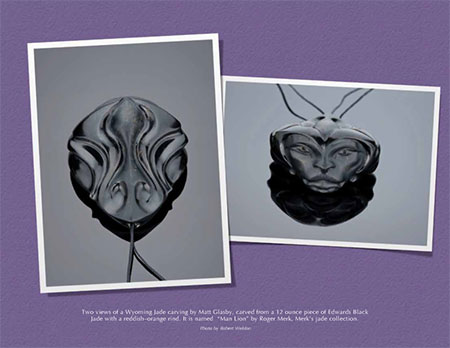 |
| Are we not men? Two views of a Wyoming jade carving by Matt Glasby, carved from a 12-ounce piece of Edwards Black Jade with a reddish–orange rind. It is named “Man Lion” by Roger Merk, Merk’s jade collection. Click to enlarge. (Photo: Robert Weldon) |
 |
| The BVLGARI Emerald Suite. Gifts from Richard Burton, 1962–1967. (Photo courtesy Christie’s) |
“Oh, you’ve got green eyes…”
—“Temptation” by New Order
Actually, Elizabeth Taylor had violet eyes, but she certainly had an eye for green, as evidenced by the lead images (also shown at right) from a September 26 Mail Online photo spread. Selections from the collection of Elizabeth Taylor were placed on display in London the next day, ahead of a New York sale by Christie’s in December. Superlatives abound regarding the collection, and the photos do overwhelm.
Christie’s, for its part, has devoted a section of its website to the sale, which commences December 13. The four-day sale will feature a total selection of 269 jewels. The estimated total sale will top $30 million.
The emerald-and-diamond suite pictured above was collected over the course of many repeat trips to the Bulgari boutique on the Via Condotti in Rome during the the filming of Cleopatra in Italy. Of their time together in Rome, Richard Burton famously quipped, “I introduced Liz to beer, and she introduced me to BVLGARI.”
A portion of profits generated by admissions, events and select publications related to the sales will be donated to The Elizabeth Taylor AIDS Foundation. [back to top]
News out of Burma this month, which we can hardly ignore, isn’t directly gemstone-related, but they may have a trickle-down effect, and in at least one instance we can see a connection between a new approach and impact on Burma’s gemlands.
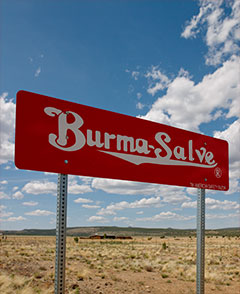 |
Perhaps the most startling development was the government’s suspension of a dam project underwritten by China, following popular opposition, on September 29. And two days before, a release of prisoners was announced, which took place last week—a release of 200 people that even The Myanmar Times (MT) yesterday called “prisoners of conscience.” News watchers may be disappointed because the original number was to be upwards of six thousand. But interest across Burma was not diminished: most “news journals” sold out between October 12, the day of the release, and October 14, according to MT. Journal vendor Ko Aung Ko Latt claimed that this prisoner release garnered more focus—outpacing last May’s freeing of more than 14,000 prisoners—was that media coverage included the P-word, political.
Press in Burma appears to be on the move, as reported earlier by MT. “Press censorship should cease as part of reforms,” read one headline, and “Ethnic-focused journal plans for November launch,” read another. There also were signs of new engagement—diplomatic but also military—with the government by ethnic groups, a reminder that Burma, nominally a “Union,” has a long history of ethnic tensions, some of which have impacted the country’s gemlands.
Yet resource-rich states like Kachin and Shan—rich also in gems and ethnic stress—have received 65% of foreign investment compared with 8% in Yangon, per an unnamed economist quoted in an undated but recent Eleven Media Group story.
 |
| Rare red. Transparent painite of this quality is quite rare. Ask for Inv #13015. (Photo: Mia Dixon) |
The July–September 2011 edition of Australian Gemmologistfeatures Rod Brightman’s “Less frequently encountered gemstones – Painite.” (Browsers of Palagems.com will encounter painite perhaps more frequently.) Brightman turns back to 1952, when only three specimens were known, bringing us up to the 21st century when a new find was discovered in Mogok.
Brightman: “Gemmy faceted specimens would still have to be regarded as an extremely rare collector gemstone and up until 2004 there were only two known faceted specimens.” [back to top]
— End October Newsletter • Published 10/18/11 —
In this edition of our newsletter we’re pleased to announce that we’ll be offering fine mineral specimens at this year’s Mineralientage München in October. Before that—next week, in fact—we’ll see you in the aisles of the September Hong Kong show. Meanwhile, in observance of encouraging signs in Burma we offer some lovely ambers from a recent visit, and some historical perspective from the concluding chapters of Martin Ehrmann’s The Ruby Mines of Mogok as well as a companion reprint from Gems & Gemology.
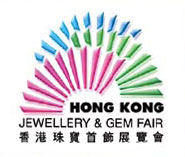 |
Pala’s Gabrièl Mattice, Bill Larson, and Will Larson are attending this fall’s largest international jewelry fair in Asia. This year’s show continues “a clear product sectorisation” between the two venues, according to the event website:
A press release states that this year’s fair already has set a new record: all booths in both fair venues are sold out. And AsiaWorld-Expo had even added a ninth hall. And this year sees the debut of the France Pavilion.
Rapaport today reported that the Hong Kong show could be “better than expected” and that a buyer’s market is anticipated. [back to top]
Pala International will be offering fine mineral specimens at this year’s Munich Show.
When: October 28–30, 2011
Where: Munich Trade Fair Centre
Hours:
Friday, October 28: 9:00 AM – 7:00 PM (Trade only)
Saturday, October 29: 9:00 AM – 7:00 PM
Sunday, October 30: 9:00 AM – 6:00 PM
Booth: Hall A6 Pavilion Booth 29
This year’s special exhibit is titled “European Classics 2011,” which brings to the show treasures from some of the most renowned museums and private collections, including the tourmalines from Elba, in the Tuscan Archipelago; hessite from the Museum of Natural History Vienna; fifty specimens leaving the British Museum of Natural History for the first time; Kongsberg silvers from Norway and gold specimens from Romania; and many more. See a streaming video overview here.
The centerpiece of these European Classics will be an exhibit of interest to colored gemstone lovers, on the history of the Wittelsbach-Graff Diamond, as the state of Bavaria celebrates The Blue Year 2011, to mark the death of King Ludwig II in 1886. Ludwig’s kindness was legend even if his attention to regnal duties lapsed in later years. He funded construction of the famous Bayreuth Festival Theatre that features the work of Richard Wagner each summer, and built a series of extravagant castles and palaces, a legacy that draws tourists to this day. (See this photo essay from The Atlantic for a taste.) Declared insane, having a sexual secret, and dying mysteriously, Ludwig’s story has been told by writers, filmmakers, playwrights, musicians—and at least one cartoonist.
 |
| Bavarian blue. Ludwig I, below, in the 1825 coronation portrait (by Joseph Stieler, famous for his depiction of Beethoven) with the crown that his father, Maximilian IV Joseph von Wittelsbach, commissioned upon his coronation as King of Bavaria in 1806. The story of the jewel in the crown, now known as the Wittelsbach-Graff, will be a featured exhibtion at the Munich show for the 125th anniversary of the death of Ludwig’s grandson, Ludwig II, whose crown, rendered differently (second below), remains in the shadows of his 1865 coronation portrait by Ferdinand von Piloty. Above, a spinel replica of the Wittelsbach (pre-Graff recutting) by Rudolf Dröschel (copyright by Dr. Bernhard Graf). |
 |
 |
While known for minerals, the Munich event includes a show-within-a-show: Gemworld Munich. As of May 30, 240 exhibitors were on board for the third year that this “world” is offered.
For more information visit the show website. See the Pala International Show Schedule for future events. [back to top]
 |
| See our ad in this year’s program. |
[back to top]
When most of us hear amber we conjure up visions of some amorphous blobs of honey-colored sap with insects trapped inside. Usually this is the state in which you find amber, but during Pala International president Bill Larson’s last trip into Burma he found that the Burmese were faceting this hardened tree goo.
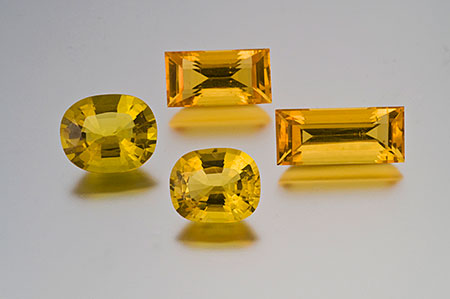 |
| Snappy sap. A choice selection of Burmese faceted amber: Inventory #19335 3.25 ct cushion; 19332 3.85 ct emerald cut; 19337 2.75 ct cushion; 19338 4.0 ct emerald cut. Click to enlarge. (Photo Mia Dixon) |
It was kind of a sweet surprise to see these colorful, faceted golden ambers, a new twist on a fairly common gem. Another interesting property is that the specific gravity of amber is so low, a 4-carat gem actually appears to be what we would normally consider a 10-carat stone. Large, light-weight, honey amber jewels…. Fun for the whole family.
See our selection of amber here.
Interested? Select the inventory number above, call (phone numbers below), or email us to inquire. [back to top]
Our featured ambers, above, are bright and clean. But ever wonder what might be lurking within less desireable material? A tiny specimen housed at the Natural History Museum in Berlin held an obscure outline, barely visible even under a microscope. The specimen was one of many from the mid-19th century collection of Georg Karl Berendt, and was said to include the oldest example of a so-called huntsman spider (family Sparassidae). The specimen in question raised doubts, however. Huntsman spiders, which today live in the tropics and southern Europe, can have a legspan of nearly twelve inches, meaning that only rarely are they trapped by tree resin. Nevertheless, the researchers, using X-ray computed tomography, which provided the detail they needed, verified this to be the oldest huntsman—49 million years old.
“The research is particularly exciting because our results show that this method works and that other scientifically important specimens in historical pieces of darkened amber can be investigated and compared to their living relatives in the same way,” said Dr David Penney, from Manchester’s Faculty of Life Sciences.
Read more on the discovery at The University of Manchester and MSNBC. The study was published in June by Naturwissenschaften. [back to top]
We look forward to blogging next month about developments at the Esmeralda Mine, which Pala International recently purchased (see last month’s story) in the Mesa Grande District of San Diego County. Stay tuned for details.
But in the meantime, mining heated up—literally—in the nearby Pala District, just before Labor Day. A wildfire, burning in all directions, covered the south side of Tourmaline Queen Mountain, home to three mines whose names will be familiar to our readers: the Tourmaline King, the Tourmaline Queen and the Stewart Mines. It was Blue Sheppard, of the Stewart’s owner Millennium Inc., who called up Erik Cordova of San Diego Mining Co. to let him know that his mines—the Tourmaline King and Queen—might be on fire, around noon on August 29.
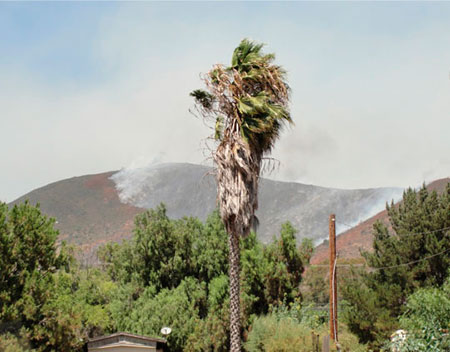 |
| Sovereign sizzles. Tourmaline Queen Mountain in flames in the early afternoon of August 29. Vegetation there hadn’t burned since the 1960s, according to a local authority. (Photo: Erik Cordova and Scott Ritchie, San Diego Mining Company) |
Cordova and business partner Scott Ritchie wasted no time in driving to the scene—Tourmaline Queen Mountain—which was on fire. Cordova gave us a detailed and illustrated report of the twists and turns that he and Ritchie experienced during the two-day fire, which we posted on our sister site, Palaminerals.com, on September 2.
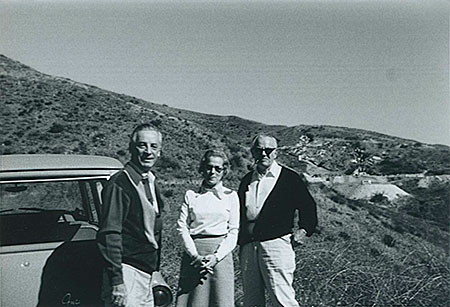 |
| Legends at the ’Lithia. Martin Ehrmann (whose “The Ruby Mines of Mogok” concludes this month, below) accompanies Dr. and Mrs. Hugo Strunz to the “Mine Bash” at the Stewart Lithia Mine on November 18, 1969. In 1941, Karl Hugo Strunz published his Mineralogische Tabellen (Mineralogical Tables) classic, a crystal classification system that he developed while curator of the Mineralogisches Museum in Berlin. (The system is now maintained at Mindat.org.) A native of Bavaria, Strunz returned there after World War II and later after 27 years at the Technische Universität Berlin. (Photo from the collection of Bill Larson) |
[back to top]
 |
| The pulsar at the center of the image is orbited by an object that is about the mass of Jupiter and composed primarily of carbon. The orbit (dashed line) would easily fit inside our Sun, represented by the yellow surface. The blue lines represent the radio signal from the pulsar, which spins around 175 times every second. (Image: Swinburne Astronomy Productions) |
The journal Science published on August 25 the discovery of “A planet made of diamond,” as it was characterized by a press release from Melbourne’s Swinburne University of Technology. (The paper was published under the more prosaic title, “Transformation of a Star into a Planet in a Millisecond Pulsar Binary.” An international team led by Swinburne’s Professor Matthew Bailes concluded that the planet—small, but with slightly more mass than Jupiter—likely is composed of carbon and oxygen, and likely crystalline, making it in essence a giant diamond.
Interesting, then, that in the grand scheme of things, Prof. Bailes played down the world-wide attention the discovery had received. When journalists asked him about the significance of the discovery, he wrote on September 13 in the online academic forum The Conversation, in the field of astrophysics, only a handful of “important theoretical astrophysicists” in the world would have been “thrilled” at the discovery. And while he still believes that for himself and the team, it will be considered career enhancing, if not career defining, and certainly a boon for the host institutions, how different all of that might have been had the team, say, “made a breakthrough in global temperature projections.” His musings on what-might-have-been are a lesson in the challenges facing the scientific method in the face of popular scrutiny. [back to top]
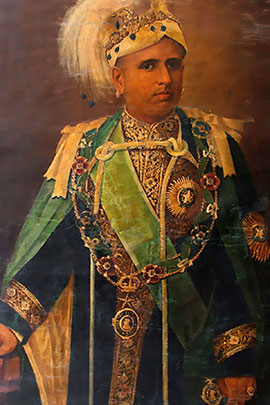 |
| Sree Moolam Thirunal was the next-to-last maharaja of Travancore. His appearance in this portrait by Shivarama Pillai is positively austere compared with the jewels that bedeck princes from other states. Perhaps that’s because most of it was in the vault? |
Controversy regarding the treasure housed at Sree Padmanabhaswamy Temple, in India’s southwestern tip, continues. Perhaps the most provocative rejoinder in the debate comes from Dr. Nissim Mannathukkaren, Associate Professor, International Development Studies Department, Dalhousie University, who, after quoting the great iconoclast poet-saint Kabir, wrote on August 28:
Are there not other ways of pleasing our gods than making them wear 18-feet-long golden necklaces? Surely, the gods are not so heartless as to embellish themselves with rubies and emeralds chiselled out of the sweat and blood of the masses who paid for them through taxes for every event from the cradle to grave, including ones like the breast tax (paid for breastfeeding) as in the case of Travancore.
Mannathukkaren refers to the princely state of Travancore, whose erstwhile royal family has been custodian of the temple treasure even as their dominion was supplanted by civil and constitutional means. The family’s Rama Varma the week before had defended the notion of keeping the single unopened temple vault closed. Several other articles, all from The Hindu, are noted here.
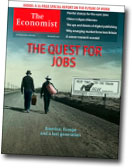 |
The September 10 print edition of The Economist noted that prices for high-quality colored stones have risen enough so far this year to put “Rubies in the sky with diamonds” (the title of the article). Dealers, the article claims, say that high-quality rubies have seen prices double in two years, and increase 50% in the last eight months. The increase has even been seen in lower quality emeralds as well as red spinel and rubellite.
Credited for the surge are demand from China and India, the security of portfolio diversification, and shortage of supply. As always, the article concludes, quality can vary, and thus reputable dealers should be consulted. [back to top]
While some pundits have likened QE2 (the Fed’s second round of quantitative easing, last November) to the Titanic, Canadian blogger “mickeyman,” proprietor of the audacious The World Complex (subtitled “Interweaving threads from science, politics, economics, and history”) was bullish this week on the Wall Street–Main Street bailout symbiosis. Calling the high-end diamond retailer “that most Main Street of businesses,” mickeyman illustrates through the RapNet Price Index the nine-month plateau in 3-carat diamonds before QE2 took effect—to great effect. (RAPI took a 4% dive in August.)
A second chart, from the U.S. bureaus of labor statistics and the census, shows that while jewelry store sales from Jan 2010–May 2011 were flat or rocky, jewelry prices had a more-or-less steady incline. And Rapaport reported today that jewelry prices jumped 11% in August. [back to top]
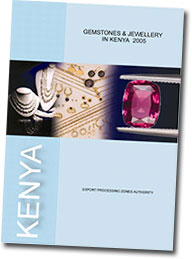 |
Last month, a reader kindly forwarded to us a 2005 document, “Gemstones & Jewellery in Kenya 2005,” issued by the government’s Export Processing Zones Authority (EPZA). The eight-page report covers a lot of high-level ground, with some history, overviews of industry sectors, market conditions, legal and regulatory issues, investment incentives and opportunities, references, and more.
Included is an interesting comparison made during the years 1999–2003 regarding the relationship between gemstone production and its export value. For instance, 2001, which saw relatively low production of ruby, still resulted in high export value. This is due to the fact that material coming into Kenya from Tanzania and Democratic Republic of the Congo was re-exported.
Five years later, a May 2010 invitation from EPZA effused,
The gemstone and jewellery sub-sector in Kenya is liberalised with no trade restrictions. So as long as a miner or dealer is licensed, he or she can trade in an otherwise free market. Dealers can sell their products either as raw material or as finished products although the value addition process is highly encouraged.
While this might sound alluring, we can’t help but recall the experience of the late Campbell Bridges, his son, and their employees, who were attacked likely due to resentment at Bridges’s perceived success in mining the green garnet that bears the name of the national park that lies nearby the deposits in Taita Taveta. “Green garnet,” in the 2005 EPZA report, is for the most part not even a pimple on the baseline of its graphs, dwarfed by ruby and gold.
It's been two years since Bridges’s death, and last year, Kenya’s Daily Nation reported that his former employees still were receiving death threats. At that time, son Bruce Bridges said that “the place had become highly insecure for them to continue with their business despite hiring Administration Police to guard the place.” At that time, armed herdsmen controlled the area. In January, the Daily Nation was upbeat with news that Taita Taveta area was rich in another mineable mineral: iron ore. Also asbestos, chalk, limestone and more. The scramble for rights was, according to the article, being accompanied by governmental oversight, efforts at obtaining residents’ consent, as well as civic education on the potential and long-term benefits of natural resource exploitation. (Yet the desperation of the very poor again was made evident in Nairobi on Monday when residents of the city’s industrial-area slum, Sinai, raced to recover fuel from a 30,000-gallon pipeline leak, only to be killed when a garbage fire ember ignited the fuel. Ironically, the slum is named after “the biblical place where Israelites sought refuge after a torturous journey from Egypt,” in tribute to settlers evicted from elsewhere, according to the Daily Nation.)
Just last month, potential Chinese investors were told to “hold on” while land ownership disputes were resolved, after investors at a beachfront plot (Taita Taveta is in Kenya’s Coast Province) were chased by residents who felt they were “sidelined” by outsiders. [back to top]
Q: What to do with all that sub-prime jade?
A: Hold a garage sale.
A local sale of low-grade jade was held August 12–16 in the administrative capital of Nay Pyi Taw, it was reported by The Myanmar Times on August 22. Dubbed the “Low-Grade Utility Jade Sale,” its 205 lots were on offer only to Burma buyers. Payments were in kyat rather than euros. A Myanmar Gems Enterprises official stated that 200 traders from 92 companies bought all 205 lots.
 |
| Smoldering. This smoky petalite from Burma is very rare. It weighs 12.40 carats and is available to the general public via our Collector’s Corner. Look for Inv #17320. (Photo: Mia Dixon) |
YANGON | Thu Sep 15, 2011 8:34 am EDT
(Reuters) – Myanmar lifts bans on foreign news websites
Several recent stories have sustained the trend amongst commentators of cautious optimism regarding Burma’s future. Last week, the BBC asked Marie Lall, South Asia expert and Chatham House NGO associate fellow, to reflect on her month-long August visit to Burma. She surely approached her trip with some skepticism; following reforms in March, ethnic conflict began, making the road ahead a little rocky. Yet while she was in the country, “quite suddenly, things started to change,” starting with president Thein Sein’s August 17th address just before parliament was to reconvene. In his speech, he invited exiles home and spoke of social and economic reform, according to Lall. She also highlighted behind-the-scenes legislative initiatives. Two days after the speech, the president met with Aung San Suu Kyi, who also attended an economic conference. This was followed by the well-publicized visit by Tomás Ojea Quintana, UN special rapporteur on human rights, whose suggestion last year that the UN should inquire into Burma’s human rights status effectively banned him from the country until August. On the 22nd, Parliament reconvened—with the non-official press in attendance. Lall had quite a summer vacation.
In late August, Reuters’s Martin Petty wrote of “rare overtures” by Burma’s leaders “toward liberalization and reform.” Harvard’s Burmese political scientist Win Min opined that Burma’s government has its eye on the rotating presidency of ASEAN in 2014—two years early—harkening back to when Maha Thray Sithu U Thant became UN secretary general. We were reminded yesterday of this last milestone by Akira Moretto, of Strategic Asia Indonesia, writing in the Jakarta Globe. Moretto—like Martin Ehrmann, in this month’s special feature below—also reminds us of Burma’s place in Asia and the world prior to the experiments of the 1960s. It’s the largest country, geographically, in Southeast Asia, bordering five countries. It’s a place where, as Moretto puts it, “China meets with India.” It’s a country, as noted by the late U Moe Hein, that has celebrated The Poets’ Day—“a venue of the minds”—for more than sixty years. And yet the country is marginalized by many. Perhaps not for long. When Forbes features a headline like “Burma Opens for Business,” as it did on Tuesday, sanctions like the Tom Lantos Block Burmese JADE Act seem a little old-fashioned.
On the other hand, a reconsideration of abandoned old-fashioned methods might be in order. Remember, in the 1990s, when foreign companies in Burma were actively engaged there (as the Forbes article notes)? Some even had the nerve to think their involvement in the country might win hearts and minds amongst the intransigent élites. But Burma’s rulers got tough and the tough got going, with foreigners’ governments taking the high, yet simplistic, road of bans and boycotts. Today, as the road is re-paved, there are bound to be bumps, and potholes are inevitable. We do well to remember that if new frictions result in foreigners erecting a tollbooth of sanctions, rutted shortcuts to India and China remain. And the toll that takes on our humanity is a shame. [back to top]
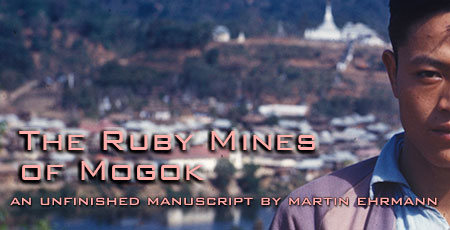 |
The second section of Chapter Five of Martin Ehrmann’s memoir of gem trading in Burma finds Ehrmann traveling with his guest Dr. Vic Meen, curator of gems and minerals at the Royal Ontario Museum, to the jade lands of Mogaung, prior to its decline as an important trading center. In addition to “5.2” we include the brief Chapter Six, in which Ehrmann takes a last visit to Mogok at about the time of Ne Win’s rise to power.
To top it off, we offer an earlier gem penned by Ehrmann, “Gem Mining in Burma,” a reprint from Gems & Gemology, Spring 1957, which covers much of the same ground regarding gems, but which includes many photographs of the people, places, and activities discussed in “The Ruby Mines of Mogok.” It also provides a snapshot in time, dwelling on natural and social aspects as well as the safety challenges—aspects that were touched on lightly in Ehrmann’s manuscript.
Having just made amends with the families of local merchants after a deal gone bad, Martin Ehrmann and Vic Meen travel to the jade lands surrounding Mogaung, learning the ways of the jade trade. They visit deposits that are mostly inaccessible, operating only three months out of the year. They watch the operations in a remote area and, while Ehrmann is worried about his companion’s health, he falls ill himself. Twenty-four hours later he’s in the office of the jade evaluation committee, being tutored on taxes.
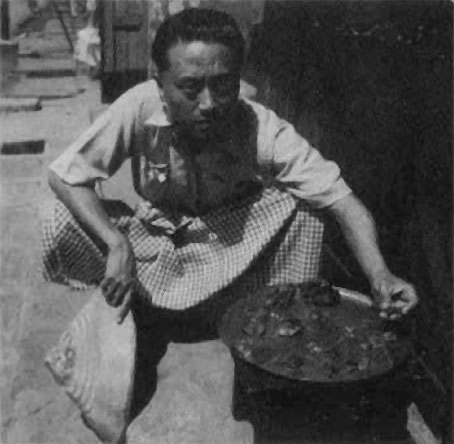 |
| Maung Myint displays rough ruby and sapphire. In our previous installment, Myint sold Ehrmann and Meen a lot that included 5-carat sapphires—“the finest cornflower blue I had seen in a long time.” Myint’s mother, Daw Phon, had other ideas. The misunderstanding led to a curse, which Ehrmann finally lifted just before he and Meen left for Mogaung. Photo: Edward R. Swoboda, from Ehrmann’s “Gem Mining in Burma” |
Next, Ehrmann and Meen experience a jade auction that is both blind and public at the same time. They buy a jadeite boulder from a dealer, but won’t know until it’s cut whether the quality is worth the price they paid. Next a visit to the amber mines producing material of “a gold color with a beautiful bluish streak through it and strongly fluorescent, even in ordinary sunlight.”
Back in Hong Kong they relieve the suspense of the quality of the jade boulder, which had been shipped there. They then take in another jade auction in the colony, using the same sort of bidding as at Mogaung. As the two friends parted, Ehrmann found the trip “especially rewarding” not for the 5-carat sapphires or lovely jade, but because of the “wonderful mineral specimens” he had bought: peridot, ruby and sapphire, “all of which are very rare in crystallized form and very difficult to obtain.”
Ehrmann is far less sanguine in Chapter Six, having been lured to Burma a last time by Burmese dealers who happened to be in Los Angeles. He was advised that “if I wanted to come to Burma once more this was the time.” Greeting him upon his arrival in Burma, again, the ghost of the 1090-carat sapphire, dashing any thoughts that on this trip he’d be able to purchase any gems of importance.
Indian merchants were being scapegoated, subjected to strip searches upon leaving. The kyat was devalued. U Ba Mhi, the partner of A. C. Pain (who eventually left Burma), was jailed for more than two years. “It was not the same Mogok I once knew. I finished my business quickly and left Mogok for Rangoon.”
Read…
[back to top]
— End September Newsletter • Published 9/15/11 —
Nature marked the lead-up to the Labor Day weekend with several wildfires in Southern California. The largest, still burning on Tuesday, but eventually contained, charred 350 acres in the area between the mining monarchs of San Diego County’s Pala District—the Tourmaline King and Tourmaline Queen.
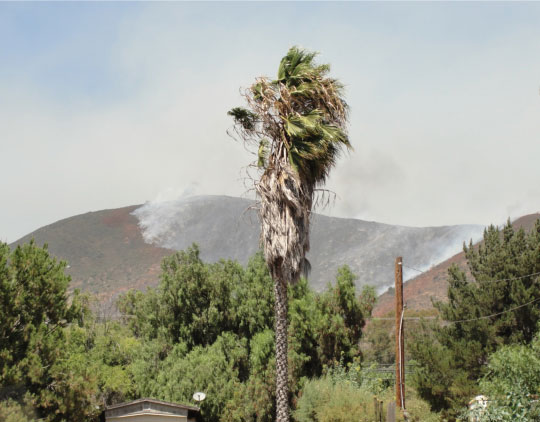 |
| Sovereign sizzles. The south side of Tourmaline Queen Mountain shows fire burning in all directions in the early afternoon of August 29. (Photo: Erik Cordova and Scott Ritchie, San Diego Mining Company) |
See this report by Erik Cordova of San Diego Mining Company—and fasten your seatbelts, it’s going to be a bumpy fright! [back to top]
2015.3 | 2015.2 | 2015.1
2014.3 | 2014.2 | 2014.1 | 2013.3 | 2013.2 | 2013.1 | 2012.3 | 2012.2 | 2012.1
2011.3 | 2011.2 | 2011.1 | 2010.3 | 2010.2 | 2010.1 | 2009.3 | 2009.2 | 2009.1
2008.3 | 2008.2 | 2008.1 | 2007.3 | 2007.2 | 2007.1 | 2006.3 | 2006.2 | 2006.1
2005 | 2004 | 2003 | 2002 | 2001 | 2000
Note: Palagems.com selects much of its material in the interest of fostering a stimulating discourse on the topics of gems, gemology, and the gemstone industry. Therefore the opinions expressed here are not necessarily those held by the proprietors of Palagems.com. We welcome your feedback.